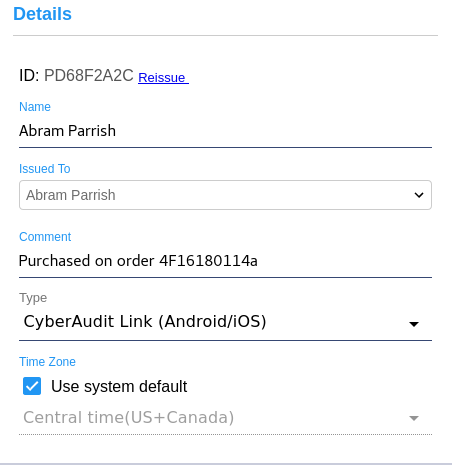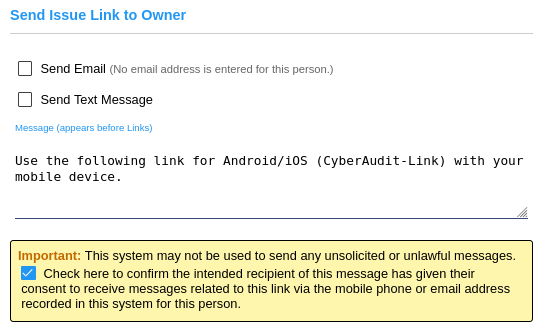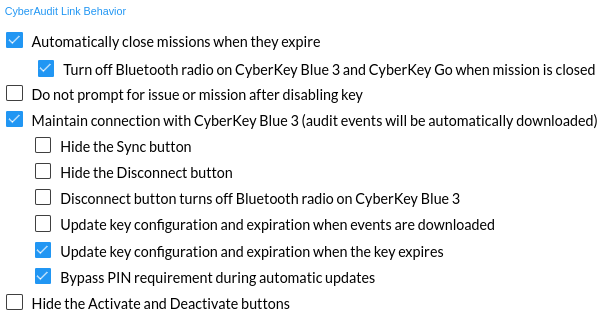 Portable Links
Portable Links

This page enables adding a new portable link or editing an existing one. It appears when clicking
 from the
toolbar of the Portable Links List
page.
from the
toolbar of the Portable Links List
page.
ID - An identifier of the Portable Link. This identifier must be present in the database before
the Portable Link may be used. When a new record is added, an issue number
will be generated. Once the portable link uses that issue number, a device ID appears which represents
a distinct instance of an app running on a device (phone, tablet, or PC).
If the user wants to replace their device, the portable link may be re-issued by clicking the reissue
link. This will replace the ID field with an issue number but keep all other settings the same.
Name - Name assigned to the Portable Link. This will cross-reference to the CyberKey Communications Log Downloaded From column to indicate which communicator downloaded the CyberKey or fob.
Issued To - The person the portable link is issued to. Binding the portable link to the person enables sending an issue link to the user by email or text to issue it. A portable link bound to a person may take notes for a CyberLock Blue and for other CyberLocks when using a CyberLock Programmer II with the CyberAudit Link app. The FlashLock Assistant app for Android or iOS can take notes for FlashLocks it encounters.
Comment - An optional field for entering additional information.
Type - There are up to seven types of Portable Links:
- CyberLink 2 (Windows) - This selection is for the CyberLink 2
PC program. It supports
- IR Encoders
- USB Stations
- direct cable connections to CyberKeys with USB ports
- RFID Card Readers to capture the card ID of RFID Access Cards
- writing a configuration file to a USB drive for a Flex 1 system
- CyberAudit Link (Android/iOS) - A device running the CyberAudit Link app. Apps are available for Android 6.0 or later, and iOS 9.0 or later. CyberAudit Link for Android can also work with an IR Encoder 10 to program CyberKeys with IR and work with a CyberLock Programmer to download and program CyberLocks.
- Flex Assistant (Android) - An Android device running the Flex Assistant app.
If FlashLocks are enabled for the system, the following two items will also appear in the list of available types. Both require the the FlashLock SEM.
- FlashLock Assistant (Windows)-Windows computers with the FlashLock Assistant app.
- FlashLock Assistant (Android/iOS) - An Android or iOS device with the FlashLock Assistant app.
The following are obsolete portable links. These two portable link types will appear when enabling obsolete portable links in communicator options.
- Windows PC with IR Port - Used in combination with the CyberAgent PC app and Gen 1 CyberKeys. This is a legacy product and is no longer supported.
- Legacy IR Encoder - For PCs running the original CyberLink program.
CyberAudit Link Behavior - When the CyberAudit Link app is selected, there are additional options for controlling its behavior. The behavior settings are normally set in Communicator Subsystem Preferences. They may be overridden for individual Cyberaudit Link Portable Links by unchecking the Use system default checkbox. Those options are described below.
Time Zone - The local time zone of the Portable Link. This determines the local time that will be programmed into the keys.

Send Issue Link to Owner - If the Issued To person has an email or mobile number record in people details, and the portable link is still an issue number an issue link may be sent when clicking Save.
Software for portable link software that runs on a PC may be downloaded from the CyberAudit-Web downloads page. The CyberAudit Link software for Android or iOS may be downloaded from the Google Play Store and from the Apple App Store.
CyberAudit Link Behavior Options

- Automatically close missions when they expire - When a
mission is used with a CyberKey, CyberAudit Link can attempt
to contact the CyberKey to close the mission when it is expired.
- The CyberKey Bluetooth radio must be always connectable and the key must be in Bluetooth range for CyberAudit Link to successfully connect to the key and close the mission.
- Supported CyberKeys for this feature include the Blue 2, Blue 3, and Flash.
- On Android, this feature will automatically run in the background and attempt to close the mission when it is expired.
- On iOS, when CyberAudit Link is in the background a push notification will appear when the mission expires reminding the user to close the mission. Tapping the notification opens the app and searches for the CyberKey.
- Turn off Bluetooth radio on CyberKey Blue 3 and CyberKey Go when mission is closed -
This setting can help increase battery life for CyberKeys that are on an active
mission for
periods of time less than one day. When this setting is used, the key holder must press the
button on the CyberKey Blue 3 or tap the CyberKey Go to
turn the Bluetooth radio on and start another mission.
Note: When the Bluetooth radio is turned off via this setting, it overrides the Bluetooth always connectable option in key settings. - Do not prompt for issue or mission after disabling key - When closing a mission, CyberAudit Link clears all access permissions from the key and disables it. This makes it available to use with another mission or to issue to a person. By default CyberAudit Link prompts for an issue or mission number after disabling a key. Check this box to skip this prompt.
- Maintain connection with CyberKey Blue 3 – When this is enabled, CyberAudit Link will not close the Bluetooth connection to the key once it is established. If the connection is lost, CyberAudit Link will try once to re-establish connection with the key. This setting pairs with the key setting Require Bluetooth connection to open lock.
- Hide Sync button – The administrator may choose to hide this button if the key will be updated when the audit trail is downloaded from the key or updated when the key is expired.
- Hide Disconnect button – This button may be hidden to discourage the key holder from disconnecting CyberAudit Link from the key.
- Disconnect button turns off the Bluetooth radio on CyberKey Blue 3 -
This setting can help increase battery life for CyberKeys that are
issued to people. It can be especially helpful when the settings
Bluetooth always connectable
and/or
Require active Bluetooth connection
are enabled.
Note: When the Bluetooth radio is turned off via this setting, it overrides the Bluetooth always connectable option in key settings. The key holder must press the button on the CyberKey Blue 3 to wake the radio before attempting to connect to it via Bluetooth. - Update key configurations and expiration when events are downloaded –
When checked, CyberAudit Link will do a full sync with the key and update its expiration
when the audit trail is downloaded.
Note: When the key is set to require a bluetooth connection to open a lock, it will notify CyberAudit Link when there is audit trail to download. - Update key configuration and expiration when the key expires – When the key is set to require a bluetooth connection to open a lock, it will automatically report to CyberAudit Link when it is expired.
- Bypass PIN requirement during automatic updates - People with a PIN set in People properties must enter their PIN each time CyberAudit Link interacts with the server and that user's CyberKey. Check this box to bypass this requirement during automatic updates when either of the checkboxes above it are checked.
- Hide the Activate and Deactivate buttons - CyberAudit-Link can deactivate a CyberKey to help ensure the key won't be used to open locks. This might be a useful precaution in case the key is misplaced. When they are ready to use the key, they would click the Activate button. These buttons may be hidden if the user will not use this feature.
|
Related Topics: Setting up and Using the original CyberKey Blue with an Android PDA/cell phone |
|
|
Portable Link Hardware |
CyberLink |
|
IR Encoder Description |
Other Communicators |

